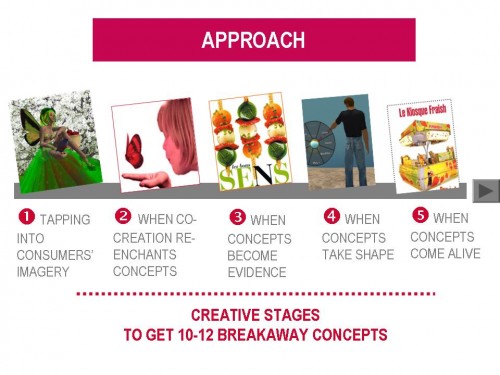In these times of economic uncertainty, disruptive innovation is increasingly essential for creating a competitive edge. At Repères we are convinced that innovation must be conducted in collaboration with the consumers to design in a meaningful and differentiating manner. Our prospective and interactive co-design protocol calls on the imagination of hyper creative consumers (recruited in the virtual world of Second Life) to help brands find new sources of inspiration.
So far we haven’t yet had the opportunity to present actual results from co-design initiatives since these are highly confidential. Today, thanks to CTIFL (Centre Technique Interprofessionnel des Fruits et Légumes – Inter-professional Technical Centre for Fruit and Vegetables) and UNFD (Union nationale des syndicats de détaillants en fruits, légumes et primeurs – National Union of Fruit and Vegetable Retailers) we have a unique opportunity to present the details of the process and its results.
I will let Emilie Labidoire, the head of the Repères Communities Department continue:
Our last project conducted for CTIFL and UNFD made it possible for us to work on the design and the offering at the same time, with a 3D model of 2 proposals from among 10.
Point of departure of the project
To adapt to new modes of consumption UNFD intends to make points of sale of fresh fruit and vegetables denser in areas of intense urban traffic through the creation of mobile outdoor kiosks and/or the setting up of dedicated gondolas with traditional retailers.
This is because, in a climate of a decline in the consumption of fresh fruit and vegetables, UNFD must take up a number of challenges:
- How to promote the purchase of fresh fruit and vegetables?
- How to reduce preparation constraints?
- How to enhance the image of fruit and vegetables (healthy, simple, quick, etc.)?
- How to prevent consumption among the young from declining further?
The Protocol

The strong points
.Greatly increases the potential of “imaginative” communities from the virtual world of Second Life® by injecting prospective visions in partnership with the agency Proâme
. Engages consumers in brainstorming on a collaborative, exploratory blog for two weeks. Presents the benefits of asynchronous communication and of a widened time frame allowing ideas to mature.
The Designs
As a result of the brainstorming session and the joint analyses of Proâme-Repères, 10 detailed proposals for kiosks and innovative fruit and vegetable corners were presented to UNFD and CTIFL, a working tool for a highly fragmented sector (different sizes and means according to geographic situation).
The two proposals selected were then modelled on Second Life® to bring to life these concepts and propose a 3-D illustration. Instead of static boards, the client and vegetable retailer teams are able to discover a space and to fully experience it to test the ergonomics, the positioning and interactions between the retailer and the client.
We presented this work at the Esomar Consumer Insights 2009 conference in Dubai and we are looking forward to seeing the kiosk open, probably in the autumn 2009!
You may also read the interview with Catherine Roty from CTFIL, whom we warmly thank, on the site dedicated to the activity of Second Life.


